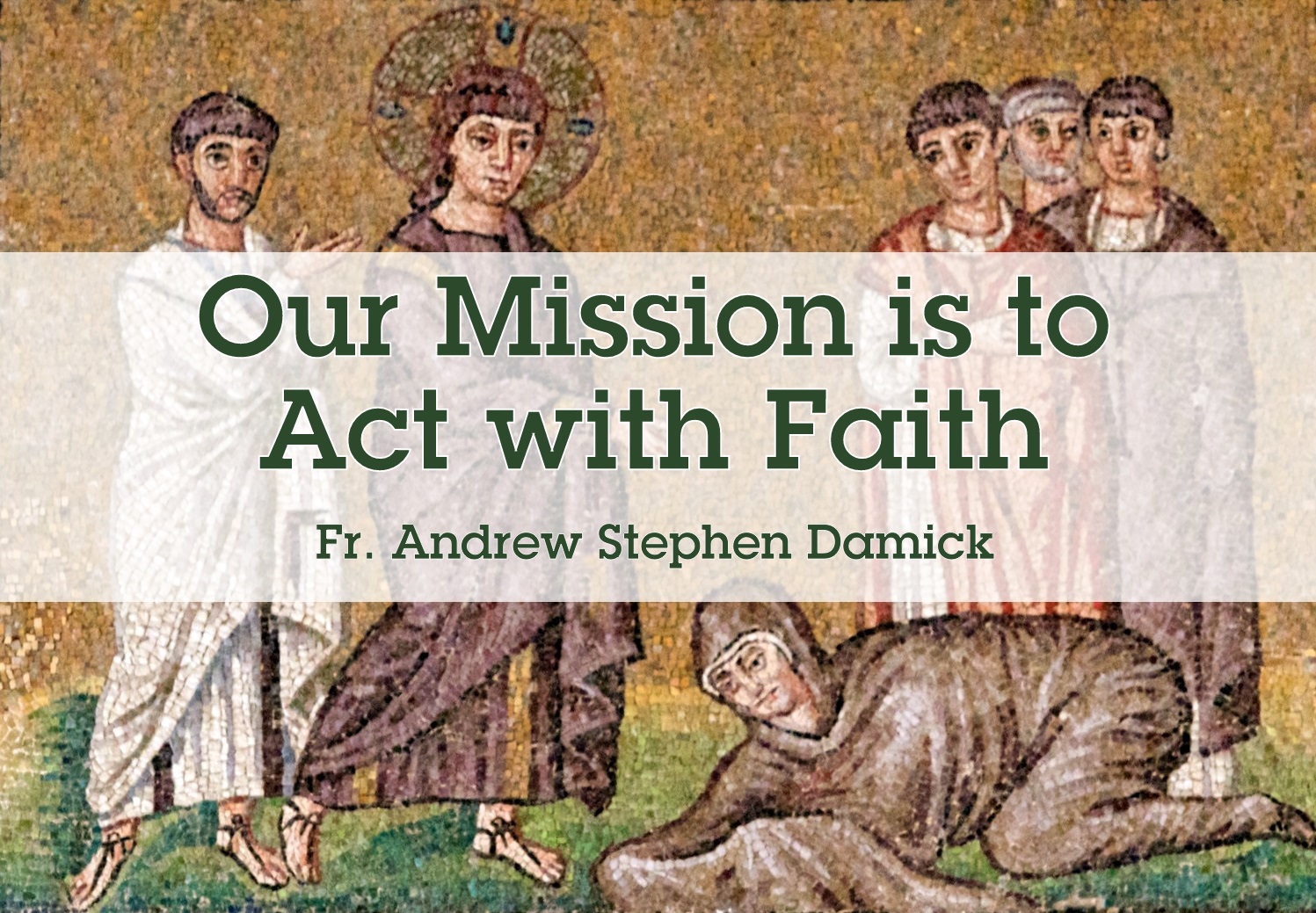
Twentieth Sunday after Pentecost / Seventh Sunday of Luke, November 6, 2016
Galatians 1:11-19; Luke 8:41-56
Very Rev. Fr. Andrew Stephen Damick
In the Name of the Father and of the Son and of the Holy Spirit, one God. Amen.
Today we hear from the Gospel about two healings performed by our Lord Jesus Christ—the healing of the woman with a flow of blood and the raising of the daughter of Jairus from the dead. If we look closely at how these two miracles happen, then we will see another facet of the theme that we are discussing for several weeks: What is our mission?
The narrative in this passage begins with Jesus being approached by Jairus, having his movement through the crowd interrupted by the sick woman, and then there is the raising of Jairus’s daughter. Let’s talk first about the incident that is bracketed by the story of Jairus—the woman with the long-term flow of blood.
The Scripture says this of her: “And a woman, who had had a flow of blood for twelve years, and had spent all her living upon physicians, and could not be healed by anyone, came up behind Him, and touched the fringe of His garment; and immediately her flow of blood ceased.”
This moment is beautifully illustrated in the commentary of St. Theophylact of Ohrid, who writes: “Like a man who brings his eye close to a bright light, or brings a dry stick close to fire, and they immediately react, so also the woman brought her faith close to Him Who has power to heal, and immediately she obtained healing.” He then says a little bit later that she first touched the Lord with her faith, and only then touched Him bodily.
Normally, when we look at moments like this, we tend to believe that what really makes the miracle happen is that this woman got close enough to touch Jesus physically—she got hold of the fringe of His garment, and so because of that physical contact, she was healed. But St. Theophylact asks us to look more deeply, to see this moment with the eyes of faith.
He says that she “brought her faith close to Him Who has the power to heal.” It was not the act of merely touching Him that made her whole. After all, as the disciples of Jesus point out, He’s in the middle of a crowd and being jostled from every side. So why did He say, “Who was it that touched me?” He could not have meant a mere physical touch, though the disciples misunderstood Him.
He explains, “Someone touched Me; for I perceive that power has gone forth from Me.” Power doesn’t go forth merely from physical touch—if it did, then miracles would have been skittering through the crowd every time someone bumped into Jesus. Yes, the woman touched Him, but she touched Him first with her faith.
Okay, remember that. Now let’s talk about the story of Jairus and his twelve year old daughter. Jairus, who is among the foremost in the community, the ruler of the local synagogue, comes to Jesus and begs Him to heal his only daughter, who is very ill and dying. He begged the Lord so strenuously that he even fell at the feet of Jesus.
In Theophylact’s commentary, he says that it was right that Jairus should fall down before Jesus, Who is God, but he was driven to it only by his desperate need. And so sometimes someone who is prominent and probably usually feels that he needs nothing may be driven to turn to what is greater than himself because of affliction. This is often why God allows us to suffer, because we do not turn to Him otherwise.
When we pick up with Jairus’s story after the healing of the woman, we see someone coming from his house to let him know that his daughter had died. And before Jairus can turn to Jesus and say anything, Jesus says to him, “Do not fear; only believe.”
Theophylact says that Jesus says this to him before Jairus can tell Him essentially, “I don’t need you any more; she’s dead, and we expected You to heal her,” which might have been on his mind, because he was not a believer in Jesus. How do we know that he was not a believer? It is the reason why Jesus says to him, “Only believe.” If Jairus had been a man of faith, it would not have been necessary to say that to him. Indeed, He did not have to say anything like that to the woman who had just been healed. He instead had said to her, “your faith has made you well.” So Jesus has to tell Jairus to have faith, because he did not.
Jesus goes to the house and brings the girl back to life, accompanied only by her parents as well as the inner circle of His disciples—Peter, James and John.
So as we look at these two incidents which are interwoven in the Gospel, we see two healings—one of a woman with a twelve-year flow of blood and one of a twelve-year-old girl whose father begged Jesus to heal her. In the first incident, a woman reaches out quietly and (she hopes) secretively with her faith, and she is healed. In the second, a prominent man publicly begs Jesus without having faith. What does this say about our mission as Orthodox Christians and as an Orthodox parish?
What is our mission? Our mission is to act with faith.
This may seem like an obvious thing to say, but the sad reality is that churches are often a locus for a lot of action without faith. I can come here early on Sunday, do all the preparations, say all the prayers, sing all the litanies, preach the sermon, serve communion, etc., and go home, but if I do all those things without the earnest desire for God in my heart, then they are effective to me only in a limited way. Or they may even be detrimental to me.
All of those acts could be very beneficial for you even if I enact them faithlessly—the Church long ago said that even a sinful, unworthy clergyman still truly performs the sacraments because it is Christ Who performs them. But if I do not bring my faith near to Christ, then even though the sacraments are real, they are not truly healing for me. The same is true of all those who pray here and receive the sacraments here.
Our hearts have to draw near to Christ, not just our bodies. Conversion is required of us, an inner change and reorientation toward God Himself. It is not enough just to show up.
Showing up itself can indeed mean that there is some faith present, but that is not always true. We all know what it’s like to show up to something without our hearts being in it.
Notice how the two people in our Gospel today approached Jesus with their desire for healing: The woman with the flow of blood approached Him secretly but with her faith engaged. Jairus approached Jesus very publicly yet without faith. They both wanted the same thing from Him, but only one was a believer. Only one reached out with faith toward the Healer. It is not enough only to want something from God—we have to love and trust and believe in Him as our Master and Savior. Our hearts have to be in it.
Churches are emptying out of those who have been “going through the motions.” This is part of why we see a rise in those who are called the “nones,” that is, those whose religious affiliation is “none,” nothing at all. But even those who remain are still subject to the temptation to come and to act, believing that wanting something and doing something are what being Christian consists of.
We of course do need to want something from God and to do something about that desire. But we must bring our hearts with us, our inner conversion toward Jesus Christ, toward an encounter and true intimacy with our God. Our mission is not merely to act. Nor is it even to act with desire. Our mission is to act with faith.
To the One Who gives us our mission, our Lord Jesus Christ be all glory, honor and worship, with His Father and the Holy Spirit, now and ever, and unto ages of ages. Amen.



